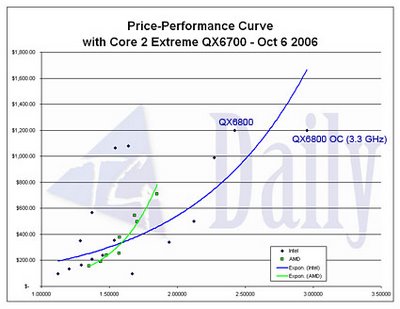 Price/Performance comparison 6 October 2006
Price/Performance comparison 6 October 2006Let's have a look at the price/performance comparison. In this chart, which does not consider the Intel quad-core processor QX6700, there is a striking difference between the performance-per-dollar values for Intel and AMD. In fact, the standard deviation for Intel's "performance per dollar" is about twice that of AMD.
n case of AMD, almost every processor currently lines up almost perfectly with an exponential price/performance trend curve, translating in a very balanced market pricing of each processor. Intel's processor prices, on the other hand, is much more radically spread out and still have to find their spots.
The Pentium Extreme Edition processors (965 and 955) are clearly overpriced at this time. At a little over $1000, the level of performance is not nearly as high as would be expected. On the flip side, there are some processors that are remarkably under-priced for the level of performance they provide. The Core 2 Duo processors (E6700 and E6600), for example, flatten the trendline for Intel and are priced more than $100 below Intel's exponential curve.
However, overclockers still find the best value in today's market with the Pentium D 805, which is currently available for an average price of $98. When overclocked to 4.1 GHz, it provides roughly the same level of performance as the $1081 Pentium EE 965, or the $546 AMD Athlon 64 FX-60.
If you are undecided which processor to buy, our chart indicates that at least at this time, AMD processors provide more bang for the buck in the mainstream segment of the market. Until a performance index of about 1.6, which includes CPUs up to the Athlon 64 X2 4600+, the blue team remains at a disadvantage.
AMD has in fact seen improvements since our first set of charts in July. On 20 July, our first graph showed that AMD's entire price-performance curve was above Intel's. However, after AMD cut prices on the 64 X2 series, it took over the advantage in the area of low-end processors. Then, as AMD prices continued to fall, Intel's top processors took price cuts, creating the dichotomy we have now. Our graph from 25 August, looks fairly similar to what it's like today. However, the the Core 2 Extreme QX6700 on the way, there may be a new shift on the way.
 When including Intel's Core 2 Extreme QX6700 in the curve - we are using an expected retail price of $1200 for this model, the blue performance curve is slightly flattened, while AMD's current prices receive more pressure. However, AMD's curve will change significantly with the introduction of the 4x4 platform, which will - as we heard - will be available for about $800-$900 in packages of two dual-core processors.
When including Intel's Core 2 Extreme QX6700 in the curve - we are using an expected retail price of $1200 for this model, the blue performance curve is slightly flattened, while AMD's current prices receive more pressure. However, AMD's curve will change significantly with the introduction of the 4x4 platform, which will - as we heard - will be available for about $800-$900 in packages of two dual-core processors.We will have to wait for first benchmark data to determine how much of a value AMD's 4x4 systems will be. According to our curve and assuming a price of $900 - or 27% more than a current FX-62 - 4x4 will need to be 55% faster than a FX-62 system to undercut Intel's price/performance curve.
No comments:
Post a Comment